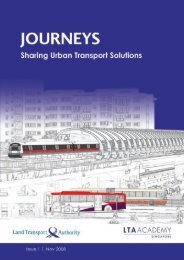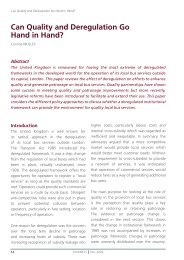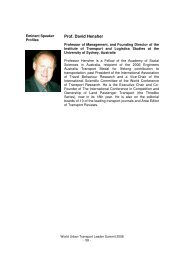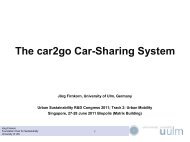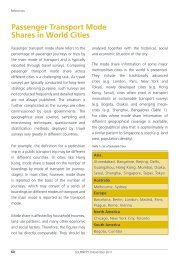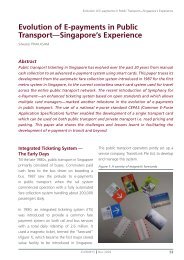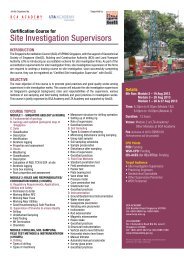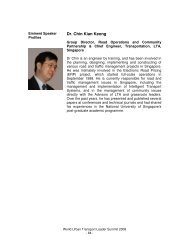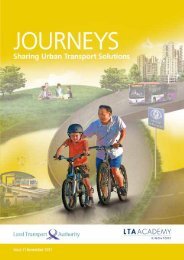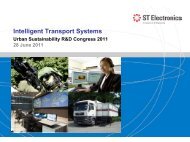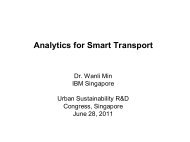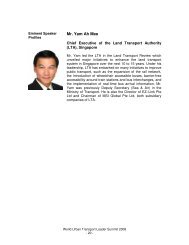Issue 4 May 2010 - LTA Academy
Issue 4 May 2010 - LTA Academy
Issue 4 May 2010 - LTA Academy
You also want an ePaper? Increase the reach of your titles
YUMPU automatically turns print PDFs into web optimized ePapers that Google loves.
Household Interview Surveys from 1997 to 2008 – A Decade of Changing Travel Behaviours<br />
Service in the 1970s, but it only took off in<br />
the late 1990s/early 2000s when there was<br />
greater emphasis on work-life balance. The<br />
impact we observed is a wider morning peak.<br />
It should be noted that even with the shift<br />
in PT trips during the morning peak, traffic<br />
conditions have not improved significantly.<br />
Fundamental changes in work practices, such<br />
as, widespread telecommuting, that could<br />
eliminate work trips will likely reduce the peak<br />
period demand.<br />
Addressing the Evolving<br />
Travel Behaviours<br />
In 2008, the Land Transport Authority came<br />
up with a bold and ambitious transport master<br />
plan that sets out the vision for the land<br />
transport system in 2020. The Land Transport<br />
Masterplan (LTMP) contains many policies and<br />
initiatives and some of them resulted from<br />
a better understanding of travel behaviours<br />
from past HITS. The 2008 HITS which came<br />
out after the review further confirmed some of<br />
the trends and highlighted the pressing need<br />
for timely implementation of the initiatives in<br />
the LTMP. In this section, we briefly review<br />
a few of these initiatives, namely, increasing<br />
the use of ERP to manage travel demand,<br />
reducing the population of cars and making<br />
PT a choice mode.<br />
Managing travel demand<br />
through ERP<br />
From the HITS results, we can see the<br />
effectiveness of the ERP. Firstly, city-bound<br />
traffic (private vehicles going into the restricted<br />
zones) grew only 15 percent compared to<br />
58<br />
JOURNEYS <strong>May</strong> <strong>2010</strong><br />
the island-wide vehicular journeys which<br />
grew 25 percent between 2004 and 2008.<br />
This suggests that traffic demand had been<br />
suppressed for areas that were priced by the<br />
ERP. Secondly, the trip distribution had also<br />
started to widen in the morning peak hours<br />
because of the imposition of the ERP and<br />
other policy changes. Therefore, the ERP has<br />
been effective in managing travel demand and<br />
ensuring better use of limited road resources.<br />
Table 3: Growth Rates of Traffic Volumes<br />
City-bound<br />
Traffic<br />
Island-wide<br />
Traffice<br />
Growth in Traffic Volumes<br />
15% 25%<br />
(Between 2004 and 2008)<br />
City-bound traffic going into the restricted zones grew less than the<br />
island-wide traffic<br />
Though ERP has been useful, the growing<br />
affluence of Singapore residents has led to a<br />
greater propensity to drive, which in turn has<br />
caused a significant increase in traffic volumes.<br />
With more cars on the road, congestion is<br />
now more prevalent, particularly during the<br />
peak periods. In the LTMP, <strong>LTA</strong> is committed<br />
to ensuring that the ERP remains effective in<br />
managing congestion. This includes refining<br />
the method of measuring traffic speeds to<br />
trigger ERP rate changes, changing the pricing<br />
structure and introducing more ERPs around<br />
the island to manage congestion in the<br />
city area.<br />
An important change is the restructuring of the<br />
ERP pricing mechanism. Instead of having many<br />
small adjustments, <strong>LTA</strong> will make larger rate<br />
increments so that the ERP charges can remain<br />
effective in influencing motorists’ behaviour.<br />
Instead of raising the incremental ERP charge



